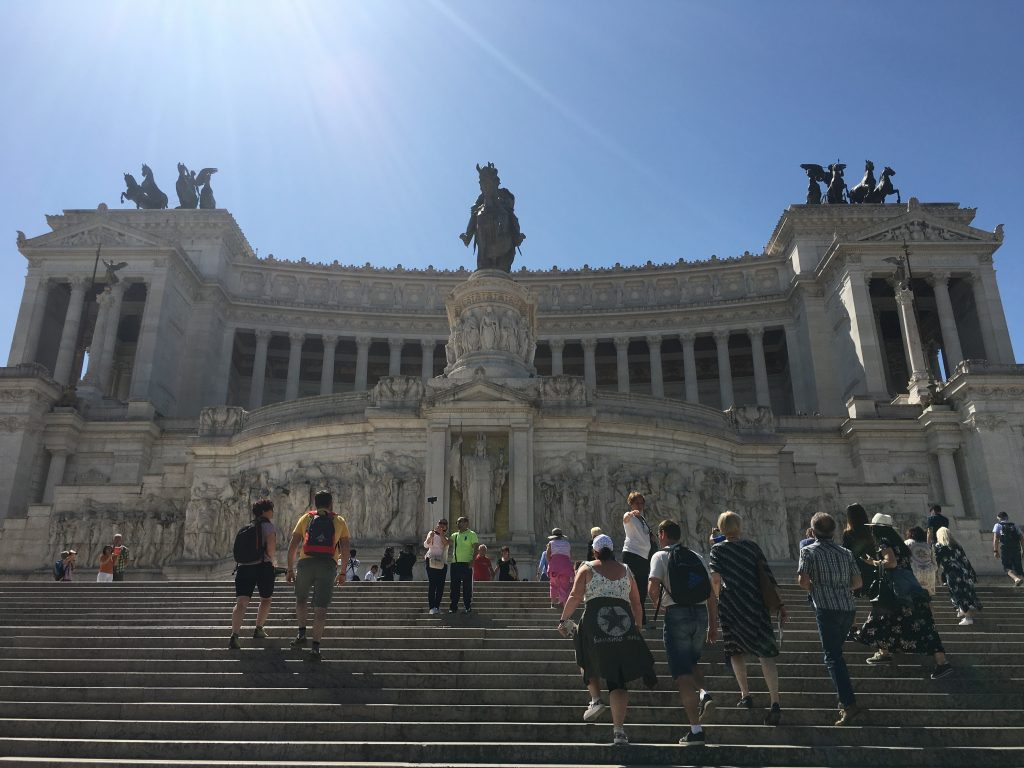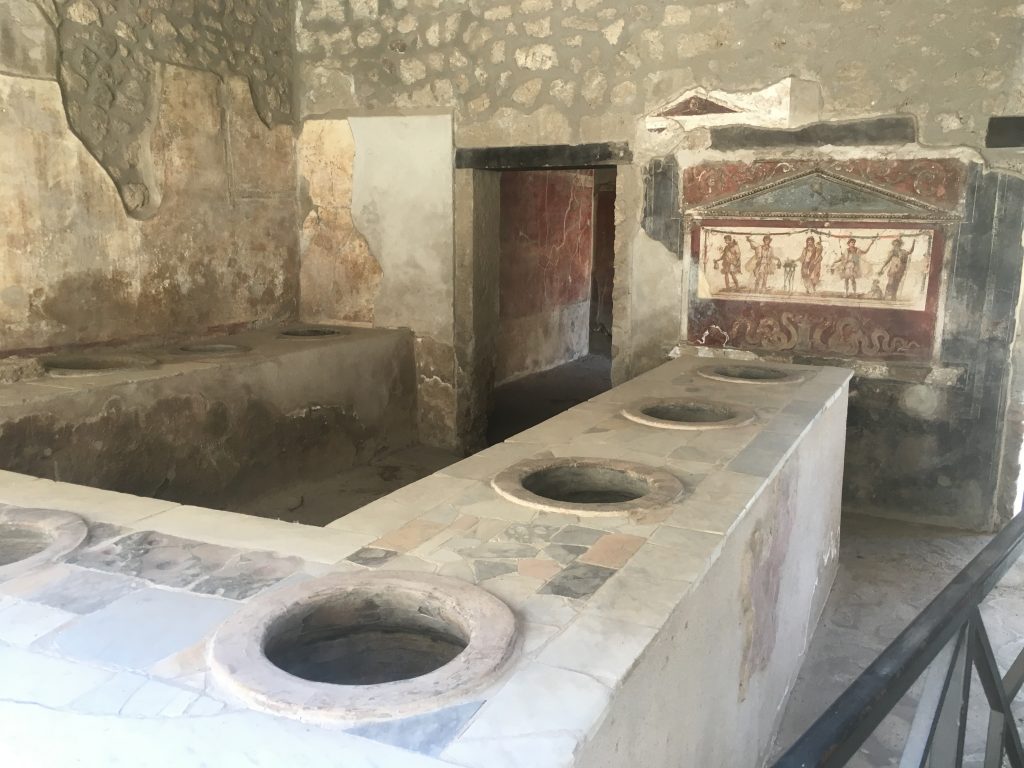
Having been raised on a steady diet of Hollywood films about Romans (their distinctly skewed view of history clings to me like the smell of stale cigarettes) I can still hear Anthony Quinn as Attila the Hun, egging his men on: “Listen allayou! Is an arpatoonity to carnker Rome!”
Thankfully, my enduring fascination with ancient Rome has more solid foundations, and who can deny feeling awestruck at the sight of their astonishing feats of engineering, even if that went hand-in-hand with a ruthlessly, efficient war machine? Never mind the brutality and violence, feel the width of that arena.
Rightly or wrongly, the overriding impression is that while the ancient Greeks were happy to muse over metaphysics and aesthetics, the Romans were far too busy building humungous aqueducts and getting dressed-up for a bloody night out at the Colosseum to ponder over such ‘trivial’ issues as philosophy.
Alas, my week-long trip was planned, not with the military precision the Romans were known for, but with all the chaotic haste of a Pompeian fleeing his home during the eruption of Mount Vesuvius.
I half expected Rome to be choked up with tourists, but nothing prepared me for the colossal size of the crowds. I should have known better, Rome has become the third most visited city in Europe after London and Paris.
Within hours of arriving I took a night stroll to avoid the masses and get a better feel of the place, and seeing St Peter’s Basilica and Hadrian’s Mausoleum lit up in the night sky was a perfect introduction to the city. Anyone who fails to be impressed by such a sight must have water coursing through their veins.

The following day I ended up by Largo di Torre Argentina, a lesser known Roman square containing the remains of temples and Pompey’s Theatre, where Julius Caesar was knifed to death, no less. These days it’s also home to a cat sanctuary, where dozens of well-fed moggies, many showing battle scars or missing limbs, can be seen sunning themselves among the ruins.
My next port of call was an unplanned visit to what must be one of Rome’s ugliest buildings – Il Vittoriano, also known as the Altare de la Patria (Altar of the Fatherland) and a string of other, less flattering names.
Built in the late 19th century in honour of Victor Emmanuel, Italy’s first king following unification, it has all the subtlety of Spain’s Valley of the Fallen. A tribute to excess, this marble monstrosity seems more like an attempt to outdo Roman grandeur while ignoring one of the main rules of architecture – proportion.

This proved to be the only blip as my next stop was the Colosseum. More than six million tourists visited the site in 2016, and when I went it looked as though they had all arrived at the same time.
A closer inspection of the Colosseum reveals the cracks. The structure may have undergone various renovations over the centuries, but even this has failed to prevent its steady decline. Despite this, the amphitheatre’s magnificence is undeniable and you almost forget the fact that thousands of people and wild animals met a gruesome end here. Completed in 80 AD, it may have taken eight years to build, but it has lasted more than 1,900 years despite the best efforts of many Popes – and the odd earthquake – to reduce it to a pile of rubble.

By the time I ended my tour of the Palatine Hill a mere stone’s throw away I was ready for lunch. If you’re a vegetarian like me and want to eat out – and if you’re not a Roman who knows their way around – you have few choices: it’s salads, pizza a la fungi, risotto a la fungi and basically anything with a mushroomy/cheesy theme. If you’re a vegan, bring your own ingredients.

I wasn’t done with that bunged-up feeling from eating bread-related products, so I ordered a calzone and eagerly bit into it. I proceeded to let out a blood-curdling yelp as a jet of molten cheese frazzled the side of my mouth. The burn was so severe I spent the rest of my holiday looking like a cross between The Joker and a patient in urgent need of herpes medication.
A cock-up with my credit card meant I was unable to pre-book a tour of the Vatican museum on my third day. I wandered over and found out to my dread that three-hour queues are the norm to get inside St Peter’s Basilica. Just as I was about to give up a guide, a lady from the Dominican Republic, waved me over and told me she could offer me the full monty – namely access to St Peter’s and the Vatican museum – for ‘just’ €46. She pointed out she was also offering me a €9 discount as she thought I was from Spain. That was nice, I thought. Then I discovered that a British woman in my group had paid €42 for the same deal. Crafty swine.
I soon forgot the mark-up once we were ushered through the museum’s doors. Looking more like an airport terminal than a repository for some of the world’s greatest works of art, the entrance sent a clear message that the Vatican likes to run a sharp operation.
But nothing quite prepared me for the artistic treasures that lay inside, amassed over the centuries by Popes who, we should not forget, were the Gordon Gekkos of their time. I was met by a whirlwind of classical statues and busts of Roman emperors and mythical Greek figures, stacked side-by-side, followed by a parade of frescoes, friezes, vases, drapes and paintings.
Our guide, Giovanni, happily reminded the group that this veritable treasure trove could only have been brought together by systematic looting. “If you wanted to preserve a Roman building it was easy, all you had to do was plant a cross in it.”
I was oddly disappointed by the Sistine Chapel and its star exhibit, The Last Judgment. Due to the fragility of Michelangelo’s masterpiece the chapel was poorly lit, and with the Vatican’s security staff hustling everyone along like a chain gang I found it impossible to give it the attention it deserved. You want to pore over The Last Judgement? Click on the picture in Wikipedia, you’ll have more time to inspect each figure and ponder over its meaning.
By contrast, the Gallery of Maps was the sucker punch. The gallery may have been named after Danti’s maps, but it’s the vaulted ceiling that’ll grab most of your attention. Casting my eyes above, I was dazzled by an explosion of light, colour and art. As I attempted to take it all in I finally got what it truly means to view one of the world’s most stunning works of art. It’s an experience that goes beyond mere intellectual appreciation.

The tour concluded inside St. Peter’s Basilica, where I watched the ‘party faithful’ solemnly line up to touch the feet of the statue of St. Peter. In fact, the guy’s toes have worn so badly from rubbing they now look like flippers. But don’t forget – today’s vandalism is often tomorrow’s history.
On to Pompeii, and no sooner had I got off at Naples train station than I spotted a young couple having a blazing row. Oblivious to all around them, they looked as though they were about to punch each other’s lights out – it could have gone either way. Yes, I was in the south of Italy. “Is laika ‘nother world!”, as my hotel receptionist put it.
Modern Pompeii may not look like much, but appearances can be deceiving. One of the main streets, the Via Sacra, has a row of delightful restaurants and nightclubs, even if a pub called ‘The British’ looks decidedly out of place (the head on my pint of Guinness had more bubbles than a bar of Aero).
I was determined to get the full sensory experience while in Pompeii, so I broke my long-standing vegetarian vow by ordering ‘Spaghetti a la Garum’, based on the eponymous fish sauce the Romans went crazy over, a bit like ali-oli for the Spanish, mayonnaise for the Belgians, and firearms for the Americans.

Ancient Pompeii is everything it says on the lava-baked tin, and in a country spoilt by historical riches, this ghostly metropolis deservedly ranks as one of the jewels in the crown.

Seeing everyday, humdrum tourists flocking in their millions to see what everyday, humdrum Pompeiians got up to is worth reflecting on, but by re-tracing their steps and stepping inside their homes, shops and brothels, visitors realise that these 2,000-year-old victims had stories to tell. They are much more than simply deathly shadows in fragile plaster casts.


I concluded that one shouldn’t be too harsh on the excesses of the ancient Romans. An empire built by men obsessed with personal hygiene and daily baths was never going to get along any nation inhabited by smelly, hairy Celts.
So my advice is get on a plane celerius quam asparagi cocuntur and follow in the mighty footsteps of Trajan, Hadrian and that creepy bloke who bedded his sister.

Photos and text: Richard Torné (May 2018)